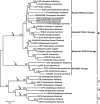Expression Pattern and Functional Characterization of PISTILLATA Ortholog Associated With the Formation of Petaloid Sepals in Double-Flower Eriobotrya japonica (Rosaceae)
- PMID: 32010167
- PMCID: PMC6978688
- DOI: 10.3389/fpls.2019.01685
Expression Pattern and Functional Characterization of PISTILLATA Ortholog Associated With the Formation of Petaloid Sepals in Double-Flower Eriobotrya japonica (Rosaceae)
Abstract
Double-flower Eriobotrya japonica, of which one phenotype is homeotic transformation of sepals into petals, is a new germplasm for revealing the molecular mechanisms underlying the floral organ transformation. Herein, we analyzed the sequence, expression pattern and functional characterization of EjPI, which encoded a B-class floral homeotic protein referred to as PISTILLATA ortholog, from genetically cognate single-flower and double-flower E. japonica. Phylogenetic analysis suggested that the EjPI gene was assigned to the rosids PI/GLO lineage. Analysis of protein sequence alignments showed that EjPI has typical domains of M, I, K, and C, and includes a distinctive PI motif at the C-terminal region. Compared with asterids PI/GLO lineage, the K1 and K3 subdomains of EjPI both contain a single amino acid difference. Subcellular localization of EjPI was determined to be in the nucleus. Expression pattern analysis revealed that EjPI expressed not only in petals, filament, and anther in single-flower E. japonica, but also in petaloid sepals in double-flower E. japonica. Meanwhile, there were high correlation between EjPI transcript level and petaloid area within a sepal. Furthermore, 35S::EjPI transgenic wild-type Arabidopsis caused the homeotic transformation of the first whorl sepals into petaloid sepals. Ectopic expression of EjPI in transgenic pi-1 mutant Arabidopsis rescued normal petals and stamens. These results suggest expression pattern of EjPI is associated with the formation of petaloid sepal. Our study provides the potential application of EjPI for biotechnical engineering to create petaloid sepals or regulate floral organ identity in angiosperms.
Keywords: Eriobotrya japonica; MADS-box gene; PISTILLATA; double-flower; ectopic expression; expression pattern.
Copyright © 2020 Xia, Shi, Chen, Hu, Jing, Wu, Wang, Li, Deng, Guo and Liang.
Figures









Similar articles
-
Ectopic expression of an Eriobotrya japonica APETALA3 ortholog rescues the petal and stamen identities in Arabidopsis ap3-3 mutant.Biochem Biophys Res Commun. 2020 Feb 26;523(1):33-38. doi: 10.1016/j.bbrc.2019.11.177. Epub 2019 Dec 9. Biochem Biophys Res Commun. 2020. PMID: 31831173
-
Heterotopic expression of B-class floral homeotic genes PISTILLATA/GLOBOSA supports a modified model for crocus (Crocus sativus L.) flower formation.DNA Seq. 2007 Apr;18(2):120-30. doi: 10.1080/10425170601060582. DNA Seq. 2007. PMID: 17364823
-
Homeotic transformation from stamen to petal in Eriobotrya japonica is associated with hormone signal transduction and reduction of the transcriptional activity of EjAG.Physiol Plant. 2020 Apr;168(4):893-908. doi: 10.1111/ppl.13029. Epub 2019 Nov 25. Physiol Plant. 2020. PMID: 31587280
-
The double-corolla phenotype in the Hawaiian lobelioid genus Clermontia involves ectopic expression of PISTILLATA B-function MADS box gene homologs.Evodevo. 2012 Nov 1;3(1):26. doi: 10.1186/2041-9139-3-26. Evodevo. 2012. PMID: 23116179 Free PMC article.
-
How to Evolve a Perianth: A Review of Cadastral Mechanisms for Perianth Identity.Front Plant Sci. 2018 Oct 29;9:1573. doi: 10.3389/fpls.2018.01573. eCollection 2018. Front Plant Sci. 2018. PMID: 30420867 Free PMC article. Review.
Cited by
-
Characterization of PISTILLATA-like Genes and Their Promoters from the Distyly Fagopyrum esculentum.Plants (Basel). 2022 Apr 12;11(8):1047. doi: 10.3390/plants11081047. Plants (Basel). 2022. PMID: 35448776 Free PMC article.
-
Characterization of Two AGAMOUS-like Genes and Their Promoters from the Cymbidium faberi (Orchidaceae).Plants (Basel). 2023 Jul 24;12(14):2740. doi: 10.3390/plants12142740. Plants (Basel). 2023. PMID: 37514354 Free PMC article.
-
Genome-wide association analyses for revealing QTN, QTN-by-environment and QTN-by-QTN interactions in soybean phenology.Theor Appl Genet. 2025 May 23;138(6):123. doi: 10.1007/s00122-025-04917-9. Theor Appl Genet. 2025. PMID: 40407902
-
A single dominant GLOBOSA allele accounts for repeated origins of hose-in-hose flowers in Sinningia (Gesneriaceae).Plant Cell. 2024 Dec 23;37(1):koae283. doi: 10.1093/plcell/koae283. Plant Cell. 2024. PMID: 39422240
-
Genome-wide identification of the apple NLP (NIN-like proteins) family and their potential role under abiotic stress.3 Biotech. 2025 Jul;15(7):210. doi: 10.1007/s13205-025-04375-6. Epub 2025 Jun 12. 3 Biotech. 2025. PMID: 40521217
References
-
- Bowman J. L., Smyth D. R., Meyerowitz E. M. (1991). Genetic interactions among floral homeotic genes of Arabidopsis. Development 112, 1–20. - PubMed
LinkOut - more resources
Full Text Sources
Research Materials
Miscellaneous

